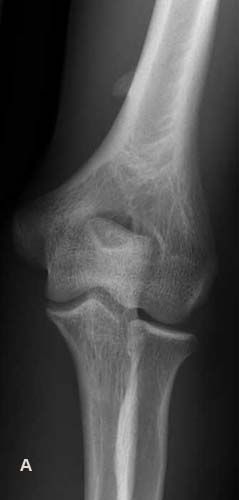Supracondylar Process
A 10-year-old boy injured his left elbow during football practice. He subsequently had pain with normal range of motion of the elbow.
A 10-year-old boy injured his left elbow during football practice. He subsequently had pain with normal range of motion of the elbow. He had minimal tenderness over his olecranon but no joint swelling, bruising, or palpable mass. He denied tingling or numbness of his fingers. His left shoulder and wrist showed no signs of injury. Distal neurovascular status was normal.

Routine anteroposterior (A) and lateral (B) radiographs of the left arm revealed a beaklike projection of the distal humerus. There was no fracture or dislocation.
A supracondylar process is a bony spur that arises from the surface of the anteromedial humerus, typically 5 to 7 cm above the medial epicondyle. It protrudes about 2 cm and points down toward the elbow joint.1,2 This is unlike an osteochondroma, which points up away from the joint. The anomaly occurs in about 0.3% to 2.7% of the population.3 The incidence is increased within families and in patients with Cornelia de Lange syndrome.4
The bony projection is a developmental variation located in the area of the supracondyloid foramen, which while present in most mammals is absent in most humans. A fibrous band, known as the ligament of Struthers, extends from the supracondylar process to the medial epicondyle.3 The supracondylar process and the ligament of Struthers create a fibro-osseous tunnel that may cause compression of the median nerve, and more rarely the ulnar nerve, called supracondylar process syndrome.
The supracondylar process is usually asymptomatic and is often found incidentally on radiographic examination after an injury, as in this patient. In rare cases, pain (usually in the elbow and forearm), paresthesias in the hand and fingers, subjective weakness of the associated extremity, and a palpable mass or swelling over the distal medial portion of the upper arm have been reported.1,3,5,6 The pain and paresthesias usually worsen with elbow extension and hand pronation. Symptoms may be of insidious onset or associated with traumatic injury, such as fracture.1,3 Conservative treatment of symptomatic patients includes rest, avoidance of exacerbating positions, analgesics, and an upper extremity sling. Operative resection of the process provides definitive cure.3,6 Rarely, regrowth of the process may occur.1,3,6

This patient's elbow pain was related to the injury not the spur and was treated symptomatically.
References:
REFERENCES:
1. Kolb LW, Moore RD. Fractures of the supracondylar process of the humerus. Report of two cases. J Bone Joint Surg Am. 1967;49:532-534.
2. Rau R, Subrahmaniam D. Supracondylar process. J Anat. 1931;65:392-394.
3. Subasi M, Kesemenli C, Necmioglu S, et al. Supracondylar process of the humerus. Acta Orthop Belg. 2002;68:72-75.
4. Curtis JA, O'Hara AE, Carpenter GG. Spurs of the mandible and supracondylar process of the humerus in Cornelia de Lange syndrome. AJR. 1977;129:156-158.
5. Bilecenoglu B, Uz A, Karalezli N. Possible anatomic structures causing entrapment neuropathies of the median nerve: an anatomic study. Acta Orthop Belg. 2005;71:169-176.
6. Tsai P, Steinberg DR. Median and radial nerve compression about the elbow. J Bone Joint Surg Am. 2008;90:420-428.